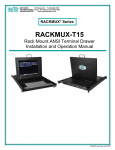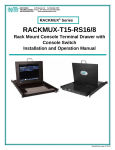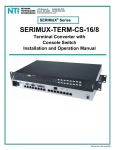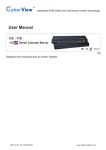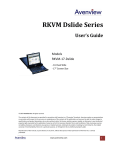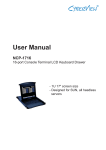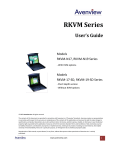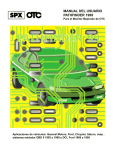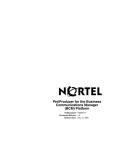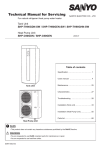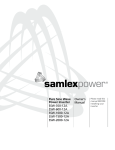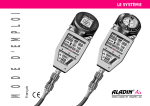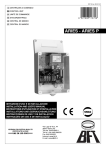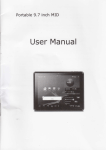Download RTERM Series User`s Guide
Transcript
RTERM Series
User’s Guide
Model:
RTERM-17T
- 1U 17” Screen Size
- Designed for SUN, all Headless Servers
© 2007 Avenview Inc. All rights reserved.
The contents of this document are provided in connection with Avenview Inc. (“Avenview”) products. Avenview makes no representations
or warranties with respect to the accuracy or completeness of the contents of this publication and reserves the right to make changes to
specifications and product descriptions at any time without notice. No license, whether express, implied, or otherwise, to any intellectual
property rights is granted by this publication. Except as set forth in Avenview Standard Terms and Conditions of Sale, Avenview assumes
no liability whatsoever, and disclaims any express or implied warranty, relating to its products including, but not limited to, the implied
warranty of merchantability, fitness for a particular purpose, or infringement of any intellectual property right.
Reproduction of this manual, or parts thereof, in any form, without the express written permission of Avenview Inc. is strictly
prohibited.
www.avenview.com
1
Table of Contents
Section 1 – Getting Started .................................................................................................................... 4
1.1
Important Safegaurds ............................................................................................................ 4
1.2
Safety Instructions ................................................................................................................. 5
1.3
Regulatory Notices Federal Communications Commission (FCC) ......................................... 5
1.4
Package Contents................................................................................................................... 6
1.5
Before Installation.................................................................................................................. 7
1.6
Unpacking .............................................................................................................................. 7
1.7
Optional Accessories .............................................................................................................. 7
1.8
Peripheral Products ............................................................................................................... 8
1.9
Structure Diagram .................................................................................................................. 8
1.10
Installation ............................................................................................................................. 9
1.11
How to Use “NCP” Series LCD Keyboard Drawer ................................................................. 10
1.12
How to Use the Slides .......................................................................................................... 11
1.13
How to Install “One Man” Installation Slides....................................................................... 12
.13.1.
Package Contents ......................................................................................................... 12
.13.2.
Install the Front Mounting Ear x 2 pcs ......................................................................... 12
.13.3.
Install into Rack ............................................................................................................ 13
1.14
Connect to Single Serial Device or Headless Server ............................................................ 14
1.15
Connect to Multi-port IP Serial Console .............................................................................. 15
1.16
Device Setup ........................................................................................................................ 16
.16.1.
Entering SETUP ............................................................................................................. 16
.16.2.
Saving and Exiting SETUP ............................................................................................. 17
1.17
Changing Operating Parameters.......................................................................................... 18
1.17.1. Color Palettes Table ......................................................................................................... 25
1.18
Local Keyboard Command in Native Mode ......................................................................... 27
1.19
Connector Pin Assignment................................................................................................... 28
1.20
Command Guide .................................................................................................................. 29
www.avenview.com
2
1.21
Variable Values for Commands............................................................................................ 41
1.22
Using the Printer Server in Ethernet Terminal .................................................................... 48
1.22.1 Introduction ...................................................................................................................... 48
1.22.2 Basic Setup ........................................................................................................................ 48
1.22.3 Setup for LPD ..................................................................................................................... 49
1.22.4 LDP Printing ....................................................................................................................... 50
1.22.5 Setup for TFTP ................................................................................................................... 51
1.22.6 TFTP Printing ..................................................................................................................... 51
Section 2: Operations ........................................................................................................................... 52
2.1
On-screen Display Operation ............................................................................................... 52
2.2
On-screen Menu .................................................................................................................. 53
Section 3: Specifications....................................................................................................................... 55
3.1.
Keyboard & Mouse .............................................................................................................. 56
4.1
DC Power Option ................................................................................................................. 56
Section 5: Troubleshooting .................................................................................................................. 57
Section 6: Dimensions .......................................................................................................................... 58
www.avenview.com
3
Section 1 – Getting Started
1.1
Important Safegaurds
Please read all of these instructions carefully before you use the device. Save this manual for future
reference.
What the warranty does not cover
Any product, on which the serial number has been defaced, modified or removed.
Damage, deterioration or malfunction resulting from:
Accident, misuse, neglect, fire, water, lightning, or other acts of nature, unauthorized
product modification, or failure to follow instructions supplied with the product.
Repair or attempted repair by anyone not authorized by us.
Any damage of the product due to shipment.
Removal or installation of the product.
Causes external to the product, such as electric power fluctuation or failure.
Use of supplies or parts not meeting our specifications.
Normal wear and tear.
Any other causes which does not relate to a product defect.
Removal, installation, and set-up service charges.
www.avenview.com
4
1.2
1.3
Safety Instructions
Unplug equipment before cleaning. Don’t use liquid or spray detergent; use a moist cloth.
Keep equipment away from excessive humidity and heat. Preferably, keep it in an air-conditioned
environment with temperatures not exceeding 40° C (104° F).
When installing, place the equipment on a sturdy, level surface to prevent it from accidentally falling
and causing damage to other equipment or injury to persons nearby.
When the drawer is in an open position, do not cover, block or in any way obstruct the gap between
it and the power supply. Proper air convection is necessary to keep it from overheating.
Arrange the equipment’s power cord in such a way that others won’t trip or fall over it.
If you are using a power cord that didn’t ship with the equipment, ensure that it is rated for the
voltage and current labelled on the equipment’s electrical ratings label. The voltage rating on the
cord should be higher than the one listed on the equipment’s ratings label.
Observe all precautions and warnings attached to the equipment.
If you don’t intend on using the equipment for a long time, disconnect it from the power outlet to
prevent being damaged by transient over-voltage.
Keep all liquids away from the equipment to minimize the risk of accidental spillage. Liquid spilled on
to the power supply or on other hardware may cause damage, fire or electrical shock.
Only qualified service personnel should open the chassis. Opening it yourself could damage the
equipment and invalidate its warranty.
If any part of the equipment becomes damaged or stops functioning, have it checked by qualified
service personnel.
Regulatory Notices Federal Communications Commission (FCC)
This equipment has been tested and found to comply with the limits for a Class B digital device, pursuant to
Part 15 of the FCC rules. These limits are designed to provide reasonable protection against harmful
interference in a residential installation.
Any changes or modifications made to this equipment may void the user’s authority to operate this equipment.
This equipment generates, uses, and can radiate radio frequency energy and, if not installed and used in
accordance with the instructions, may cause harmful interference to radio communications.
However, there is no guarantee that interference will not occur in a particular installation. If this equipment
does cause harmful interference to radio or television reception, which can be determined by turning the
equipment off and on, the user is encouraged to try to correct the interference by one or more of the
following measures:
Re-position or relocate the receiving antenna.
Increase the separation between the equipment and receiver.
Connect the equipment into an outlet on a circuit different from that to which the receiver is
connected.
www.avenview.com
5
1.4
Package Contents
1
Console Terminal LCD Keyboard drawer
1pc
3
330mm rear mounting L-bracket x 1 pair
RTERM-17T mounting depth-adjustable from
320mm to 920mm
5
Power cord
x
x
2
Fasteners for rear L-bracket
4
User manual
x 4 pcs
x 1 pc
1 pc
www.avenview.com
6
1.5
1.6
Before Installation
It is very important to locate the Console Terminal LCD Keyboard Drawer in a suitable environment.
The surface for placing and fixing the Console Terminal Drawer should be stable and level or mounted
into a suitable cabinet.
Make sure the place has good ventilation, is out of direct sunlight, away from sources of excessive
dust, dirt, heat, water, moisture and vibration.
Position the Console Terminal LCD Keyboard Drawer with respect to related facilities.
Unpacking
The Console Terminal LCD Keyboard Drawer comes with the standard parts shown on the package contents.
Check and make sure they are included and in good condition. If anything is missing, or damage, contact the
supplier immediately.
1.7
Optional Accessories
RJ45-DB9 Adapter
SG-100F
RJ45-DB9 female adapter
SG-100M
RJ45-DB8 male adapter
Cat 5 Cable
CU-3
CU-6
CU-10
3 feet cat5 cable
6 feet cat5 cable
10 feet cat5 cable
CU-15
CU-33
CU-66
15 feet cat5 cable
33 feet cat5 cable
66 feet cat5 cable
“One Man” installation Slides
NBK-01 Single or “One Man” installation Slides
*Please refer to page 12 – 13 for installation guidelines
Power Cord
IEC power cord
NEMA 5-15 power cord (US)
BS 1363 power cord (UK)
CEE 7/4 power cord (German)
AS 3112 power cord (Australia)
www.avenview.com
7
1.8
Peripheral Products
Item
Description
Cat5 IP Serial Console
16 48-port Cat5 IP Serial Consoles
1.9
Structure Diagram
1
Carry handle to release the 2-pt lock
2
2-point lock
3
LCD interchangeable module kit
4
LCD membrane
5
Adjustable rear mounting L-bracket
6
Micro switch for screen auto power off
7
Keyboard interchangeable module kit
www.avenview.com
8
1.10 Installation
Install each rear L-bracket using two fasteners
shown in Figure 1.
Leave the fasteners slightly loose
Figure 1
Measure the front and rear mounting depth of
the rack.
Align each rear L-bracket to a suitable length
and tighten the fasteners shown in Figure 2.
Fix the LCD keyboard drawer into the rack.
Figure 2
Figure 3
* Hardware (screws and cage nuts) for fixing the
mounting bracket to the rack is not provided.
www.avenview.com
9
1.11 How to Use “NCP” Series LCD Keyboard Drawer
Gently pull the tab toward the front of the LCD,
shown in Figure 4
Figure 4
Flip up the LCD to a suitable angle, as shown in
Figure 5
Figure 5
Operate the LCD keyboard drawer, as shown in
Figure 6
Figure 6
www.avenview.com
10
1.12 How to Use the Slides
A white arrow release button is located on the
outside of each slide, as shown in Figure 7
Figure 7
Push the white arrow button on either side of
the LCD keyboard drawer to unlock, as shown
in Figure 8. Avoid pressing the red button
located on either side
Figure 8
Hold down the white arrow button until the
LCD keyboard drawer is located in the rack, as
shown in Figure 9
Figure 9
www.avenview.com
11
1.13 How to Install “One Man” Installation Slides
.13.1. Package Contents
1
Mounting bracket x 2 pcs
2
Front mounting ear (left & right ) x
2 pcs
3
Support bracket x 4 pcs
4
M6 cage nut x 8 pcs
5
M6 washer x 8 pcs
6
M6*15mm screw x 8 pcs
7
M3.2*4.5mm screw x 14 pcs
.13.2. Install the Front Mounting Ear x 2 pcs
Disassemble the standard front mounting ears carefully
Install the optional front mounting ears with M3.2*4.5mm
screw x 8pcs
www.avenview.com
12
.13.3. Install into Rack
Attach the mounting brackets to vertical
mounting rails.
Leaving the screws slightly loose.
Attach left and right front mounting ears to
vertical rails.
Tighten the screws.
Attach the support brackets to chasis with
M3.2*4.5mm screws x 6 pcs
Installation complete.
Model No. NBK-01
Pickup the unit.
Insert inner members of slides into the already
mounted internal slide members in the rack.
www.avenview.com
13
1.14 Connect to Single Serial Device or Headless Server
1.
Power
AC Power input
2.
Ethernet
10Base-T RJ45 network port
3.
Serial 1
DB9 male RS232 port
4.
Parallel
DB25 male parallel port
5.
Serial 2
DB9 male serial printer port
www.avenview.com
14
1.15 Connect to Multi-port IP Serial Console
www.avenview.com
15
1.16 Device Setup
Switch on the power on the rear of RTERM-17T
.16.1. Entering SETUP
Hold down the Alt key and then depress the Esc key to enter the SETUP mode.
When you enter SETUP mode, and text on the screen temporarily disappears, and the main SETUP
directory appears. When you leave the SETUP mode, the main SETUP directory disappears, and any
text that was on the screen reappears.
Caution: Scroll lock must be off for accessing setup menu by “Alt + Esc” key.
www.avenview.com
16
.16.2. Saving and Exiting SETUP
The first menu seen when entering SETUP mode serves as a directory to the other SETUP menus. When you
depress F12 to exit Setup, you will return to this main directory and be given the option of saving your
selections.
The highlighted field at the right of the screen gives you the choice of saving or not saving parameter changes
in the nonvolatile memory before returning the terminal to the normal operating mode. If you don’t save
your setting before you leave the SETUP mode, any new selections will be lost when you power down the
console terminal drawer.
To save your SETUP selection, depress the Spacebar to change the save field at the right side of the screen
from NO to YES before exiting SETUP.
Depress F12 to exit SETUP mode and return to the normal display mode.
www.avenview.com
17
1.17 Changing Operating Parameters
To select one of the setup menu’s shown, press the indicated function key.
The screen for that menu appears with the name highlighted.
The fields in the middle of the screen, indicate the parameters that you can change in that menu.
The top line identifies the keys you press to highlight the parameter fields and change the settings.
The procedure is:
Use arrow key to highlight the parameter field you want to change.
Use the Spacebar to change the parameter.
F12 always returns you to the top menu.
The following tables list the parameters for each menu and explains their settings.
Default settings are listed first unless otherwise noted.
Columns
Sets the screen display for 80 columns, 132 columns, or Econ-80. (80 columns with more
pages of memory)
Lines
Sets the screen display for 24, 25, 42 or 43 lines. (25 lines is normally required for PC Term)
Page Length
Sets the length of a page of display memory to:
1 x Lines: Equal to the number of lines selected in the lines parameters
2 x Lines: Two times the value of the lines parameter
4 x Lines: Four times the value of the lines parameter.
Equal to the value of the lines parameter, with a second page containing the rest
of the lines remaining memory.
Cursor
Sets the cursor display to blink or steady, block or underline.
Background
Sets the screen display to Dark (light characters on a dark background) or Light (dark
characters on a light background)
Auto Page
Causes a new page of memory to move onto the screen when the cursor reaches the top or
bottom of the page.
Screen Saver
Off, 1, 2, 3, 4, 5, 6, means no saver. 5, 10…. Minutes saver
Width Change
Clear
Causes the terminal to clear the screen when executing a command to change the number
of columns.
Revers
Off / On control function: ANSI, VT-100 and VT-200
“Off” means, when SGR command ESW [3? m and ESC
[4? m select background and foreground color change respectively.
“ON” means, when SGR command ESC [3? m and ESC
*4? m select foreground and background color change respectively. )?? Can be 0, 1, 2… 7)
Display
CRT/LCD choose which kind of monitor be used. If LCD monitor is selected, the display
columns any support 80 columns on Econ-80 columns.
www.avenview.com
18
Personality
Sets the terminal’s operating mode to Wyse 325, Wyse 120/Wyse 60 (native mode), Wyse
50+ (WY-50, WY-50+, WY-100, ADM 31/5/3a), TeleVideo TVI 925, TVI910+ (includes 910),
ADDS A2, Digital Equipment VT-100, VT-220 7 bits, VT-220 8 bits, VT-52, Console ANSI, PC
TERM, PCG Alpha.
Scroll Speed
Sets the display scroll rate to Jump (the rate data is received), Smooth-8 (eith lines per
second), Smooth-4, Smooth-2, or Smooth-1
Rcvd CR
Causes the cursor to move to the beginning of the current line (CR) or the beginning of the
next line (CRLF) when the terminal receives an ASCII CR.
Enhance
Allows the terminal to recognize an enchanced set of codes when the terminal is not in the
native personality.
Auto Scroll
Causes the data to scroll up a line when the cursor moves past the last line of the page.
Monitor
Causes the terminal to display symbols for escape sequences and control codes without
acting on them (Test Feature).
Status Line
Sets the top line of the screen as the status line.
End of Line
Warp
Causes the cursor to move to the start of the next line when additional characters are
entered at the end of a line.
Attribute
Sets display attributes to be assigned to each character as it is entered (Char), to be active
to the end of the line (Line), or to be active to the end of the page (Page).
Xmt Limit
Causes the terminal to send data through the HOST port as the baud rate allows (None) or
at a maximum rate of 60 cps or 150 cps. In older system limiting character rate is necessary
to prevent loss of data.
Language
Sets correct terminal operating for the language of keyboard connected to it: US, UK,
Danish, German, Spanish, Swedish, Norwegian, Italian, French, Belgian, French, German.
Key Repeat
Off, 1 … 8
Margain Bell
Sets the terminal’s bell to ring when the cursor reaches the column where the bell is set
(default is column 72 in 80-column mode or 124 in 132 column mode).
Keycode
Sets the terminal to send normal ASCII characters *ASCII) or PC-type scan codes for every
key up / down (Scan). Scan is required for the PC Term personality.
Keyclick
Sets the terminal to sound a muted beep each time a key is pressed or repeated.
NRC
Sets the terminal to have national replacement character functional.
Bell Volume
Off, 1, 2, 3 (3 different volume)
Num Start
Off / On when the terminal power on, this field determines whether the numeric pad starts
as Numeric (NUM On) or Function (NUM Off).
8 different repeat rates after a key has been depressed for about 1/2.
www.avenview.com
19
Baud Rate
Sets the host port baud rate to 50, 110, 134.5, 200, 300, 600, 1200, 2400, 4800, 7200, 9600,
19200, 38400, 57600, 76800 or 115200.
Rcy Hndshake
Allows the terminal to control the receipt of data from a device connected to the SERIAL1
port with no handshaking (None). Xon / Xoff handshaking. DTR handshaking, DTR / Xoff
handshaking, or by sending special codes (XPC). CPS is possible only when the personality
parameter is set to PC Term.
Data / Stop Bite
Through the SERIAL1 port, the terminal to send and receive 8-bits data with on stop bit or
two stop bits, or 7-bits data with on stop or two stops bits.
Xmt Hndshake
Xmt Hndshake causes the terminal, when sending data to a device connected to the
SERIAL1 port, to ignore all Incoming software hand-shaking singles (None) or to control
data output in respons to Xon/Xoff handshaking.
Partly
Cuases the terminal send the data to the SERIAL1 port with none, odd, mark, even, or space
partly.
Comm Mode
Sets the SERIAL1 port communication mode to full duplex (FDX), block (BLK), half duplex
(HDX), or half-duplex block (HBLK)
Printer Selection:
Parallel: Sends data to a parallel printer connected to the parallel port
Send data to a serial printer connected to the SERIAL2 port
Serial:
Ignores the printer command
Off:
Ethernet Mode
On / Off to set the communication routing by Ethernet Network or Serial Port.
Multiple
Sessions
Defines Ether terminal have multiple sessions function:
ON: Indicates the terminal has multiple sessions function, but each session only has one
page display. In 80 or 132 column mode, 4 session simultaneously. In Econ-80 colum mode
7 sessions simultaneously.
OFF: Indicates the terminal only has single session, but it has multiple pages display.
www.avenview.com
20
Wprt Intensity
Normal, blank, dim, blank / dim
Block End
Causes the terminal to send a block of data to the computer with a line terminator as an
ASCII US character and block terminator as an ASCII CR character (US / CR), or with line
terminators as ASCII CR and LF character and the block terminator as an ASCII ETX
character (CRLF / ETX).
Wprt Reverse
Sets the write-protected characters to appear in reverse (dark characters on a light
background).
Wprt Underline
Sets the write protected characters to appear underlined.
Ptr Baud Rate
Sets the SERIAL 2 port baud rate to 75, 150, 300, 600, 1200, 2400, 4800, 7200, 9600, 19200,
38400, 57600, 76800, 115200, 230400, 460800.
Ptr Data / Stop
Bits
Through the SERIAL 2 port ,the terminal to send and receive 8-bits data with one stop bit or
two stop bits, or 7-bits data with one stop or two stops bits.
Ptr Partly
Causes the terminal to send the data to the SERIAL 2 port with none, odd, mark, even, or
space parity.
Ptr Xmt
Hndshake
None, DSR, Xon / Xoff, Both
Ptr Rcy
Hndshake
None, DTR, Xon / Xoff, DTR/Xoff
On the tabs setup menu screen, the terminal’s current tab stops are indicated by uppercase T’s displayed
along a line of periods that mark each column position.
(1)
(2)
A tab stop in columns 2 through 78 is shown as a T in the upper line of periods
A tab stop in columns 79 through 132 is shown as a T in the lower line of periods
You can easily determine where tabs are set by moving the cursor across the line and reading the column
number displayed on the right side of the screen.
Clear and set tabs anywhere on the line, as follows:
(1)
(2)
(3)
(4)
To move the cursor across the line, press
or
To either clear or set (toggle) an individual tab stop at the cursor position, press
To clear all tabs, press
To set tabs to the default setting (every eighth column), press
Note: A tab stop cannot be set to column 1.
www.avenview.com
21
You can redefine the function keys and many of the editing keys to send a unique character string of up to 64
characters. Keys that are not programmed will send a default sequence which is determined by the personality
selected. Below table lists the programmable keys.
To redefine a key:
1. Select the key to be redefined by pressing that key together with
field.
2. Press
. This highlights the key’s definition
to select the shifted or unshifted key definition field.
3. Enter the key definition (up to 62 characters) at the cursor position. Correct errors by pressing
delete characters or
to clear the definition.
4. If you want to change the key’s direction, press
to
(on the numeric pad) until your choice appears.
Direction determines where the key data is transmitted:
- Remote:
Sends data to the computer only, regardless of the terminal’s communication mode.
(Until redefined, the direction of all the programmable keys is remote.)
- Local:
Sends data to the terminal only, regardless of the terminal’s communication mode
- Normal:
Sends data to the computer and / or the terminal, depending on the terminal’s
communication mode
Programmable Keys
Enhanced PC-Style Keyboard
Enhanced Pc-Style Keyboard
F1 throught F12
*ENTER
Arrow Key
ESCAPE
Arrow Key
HOME
Arrow Key
INSERT
Arrow Key
PAGE DOWN
BACKSPACE
PAGE UP
DELETE
PRINT SCREEN
END
TAB
*Both ENTER keys are programmable
www.avenview.com
22
You can program a message of up to 20 characters to identify the terminal to the computer. Enter the
message at the cursor position. Correct errors by pressing
to delete characters or
to clear
the message.
CONCEAL hides the answerback message, so it is not displayed in SETUP mode.
To save the message in nonvolatile memory, exit SETUP mode with the YES option.
This menu allows the terminal setup for Ethernet communication. Use of Ethernet communications provides
the additional ability to open multiple sessions (applications) on one or more hosts/servers at the same time.
Support of these extended features requires the creation of special files at the host computer(s) by the MIX
manager for your system. The settings selected by the MIX at the host(s) must also be entered in this menu for
proper communications.
Note: The Ethernet option in the F4 setup menu must be set to ON for the terminal to work in an Ethernet
environment.
Ethernet Node
ID
Displays the serial number of the hardware Ethernet Interface device. This is a default value
of the manufacturer of the hardware device and should not be changed.
Local IP
Address
The IP address assigned to this terminal by the MIS manager. Each terminal must have a
unique IP address. The address is used to allow the host to identify messages from this
terminal and to allow the terminal to filter out return messages from the common Ethernet
cable. An example of this address is 192.168.123.211.
Netmask
The value generated by the system based on the IP address. The system administrator
would have this information. An example is 255.255.255.0
Remote IP
0…B Address
For any remote host, or devices, that the terminal will communicate with for a specific
session. These twelve remote IP addresses should all be identical if all communications
will be with only one host. If Multisession ON in the F4 menu has been selected, and here
is more than one host on your system, you must specify which host each session will
communicate with. To communicate with a different host for a future session, these
settings be changed.
Note: The multisession option allows 4 separate sessions. If any emulation other than
ECON-80 is selected. If ECON-80 emulation is selected, the Multisession option allows up to
7 separate sessions.
Gateway
This IP address is used to communicate with other networks. If a gateway is not being used
this option should be blank.
Term Type
Allows definition of the terminal with up to 40 characters. If Term is empty the default type
is sent to the host by the system.
www.avenview.com
23
The color functionality differs with emulation.
In general VT100, VT220 and ANSI Console work with applications which control the color directly. The
remaining personalities associate colors based on existing monochrome video attributes.
This section will define parameter selection based on personality selected.
Background will determine the color of the background screen under some conditions (16 colors).
Cursor
Select the color of the cursor (16 colors).
Normal F.G. /
Normal B.G
These fields allow you to select the character and background color (16 colors) for data
entered on the display before your application defines the color display remotely
Intensity F.G. /
Intensity B.G.
These fields allow you to select the character and background color (16 colors) for data
entered on the display as Dim in ASCII emulation’s and Bold in VT\ANSI emulation’s before
your application defines the color display remotely.
Color Mode
Is automatically selected based on your emulation selected.
Color Map
Applies in WY325 mode only and determines if the monochrome attribute Reverse or Blank
will be used to map monochrome attributes to color.
ASCII (NOT WY325)
WY325*
VTXXX
Background
The whole data area of the screen will
be display in this color when application
hasn’t entered character or space with
the Normal or Intensity B.G. color.
No Function
Same as ASCII
Same as
ASCII
Cursor
Selects Cursor color
Selects
Cursor color
Normal F.G.
Selects color or Normal F.G.
No Function
Normal B.G.
Selects color or Normal B.G.
No Function
Intensity F.G.
Selects color or Intensity F.G.
No Function
Intensity B.G.
Selects color or Intensity B.B.
No Function
Selects
Cursor color
Initial color
selection at
power up
Initial color
selection at
power up
Initial color
selection at
power up
Initial color
selection at
power up
Selects
Cursor color
Initial color
selection at
power up
Initial color
selection at
power up
Initial color
selection at
power up
Initial color
selection at
power up
Color Mode
(Normal /
Palette)
Color Map
(Reverse / Blank)
ANSI
CONSOLE
Automatic
Automatic
Automatic
Automatic
No Function
See Above
No Function
No Function
* When the WY325 personality is selected holding the CTRL key down and depression either the 0, 1, 2…9(.) period key in
the numeric pad changes the assignment of color the screen. Each selection is called a palette as mention in Color Pallete.
www.avenview.com
24
1.17.1. Color Palettes Table
Palette
Display Attribute
Normal
Reverse ( or Blank) *1
Intensity *2
Intensity *2 and reverse (or Blank) *1
Underline
Underline and reverse (or Blank) *1
Underline and Intensity *2
Underline, Intensity *2 and reverse (or Blank) *1
Normal
Reverse (or blank)*1
Intensity*2
Intensity*2 and reverse (or blank)*1
Underline
Underline and reverse (or blank)*1
Underline and intensity*2,*3
Underline, intensity,*2 and reverse (or blank)*1
Normal
Reverse (or blank)*1
Intensity*2
Intensity*2 and reverse (or blank)*1
Underline
Underline and reverse (or blank)*1
Underline and intensity*2,*3
Underline, intensity,*2 and reverse (or blank)*1
Normal
Reverse (or blank)*1
Intensity*2
Intensity*2 and reverse (or blank)*1
Underline
Underline and reverse (or blank)*1
Underline and intensity*2,*3
Underline, intensity,*2 and reverse (or blank)*1
Foreground Color
Green
Black
Blue
Black
Cyan
Black
Red
Black
Green
Black
Yellow
Black
Cyan
Black
White
Black
Cyan
Black
Red
Black
Magenta
Black
Blue
Black
Cyan
Black
White
Black
Magenta
Black
Yellow
Black
Background Color
Black
Yellow
Black
Blue
Black
Cyan
Black
Red
Black
Red
Black
Yellow
Black
Cyan
Black
White
Black
White
Black
Red
Black
Magenta
Black
Blue
Black
Blue
Black
White
Black
Magenta
Black
Yellow
4
Normal
Reverse (or blank)*1
Intensity*2
Intensity*2 and reverse (or blank)*1
Underline
Underline and reverse (or blank)*1
Underline and intensity*2,*3
Underline, intensity,*2 and reverse (or blank)*1
Magenta
Black
Blue
Black
Green
Black
Red
Black
Black
Cyan
Black
Blue
Black
Green
Black
Red
5
Normal
Reverse (or blank)*1
Intensity*2
Intensity*2 and reverse (or blank)*1
Underline
Underline and reverse (or blank)*1
Underline and intensity*2,*3
Underline, intensity,*2 and reverse (or blank)*1
Magenta
Black
White
Black
Green
Black
Cyan
Black
Black
Yellow
Black
White
Black
Green
Black
Cyan
0
1
2
3
www.avenview.com
25
Display Attribute
Foreground Color Background Color
Normal
Yellow
Black
Reverse (or blank)*1
Black
Yellow
Intensity*2
Red
Black
Intensity*2 and reverse (or blank)*1
Black
Red
6
Underline
Cyan
Black
Underline and reverse (or blank)*1
Black
Cyan
Underline and intensity*2,*3
Magenta
Black
Underline, intensity,*2 and reverse (or blank)*1
Black
Magenta
Normal
Red
Black
Reverse (or blank)*1
Yellow
Red
Intensity*2
Magenta
Black
Intensity*2 and reverse (or blank)*1
Black
Magenta
7
Underline
Cyan
Black
Underline and reverse (or blank)*1
Black
Cyan
Underline and intensity*2,*3
Green
Black
Underline, intensity,*2 and reverse (or blank)*1
Black
Green
Normal
White
Black
Reverse (or blank)*1
Black
White
Intensity*2
Red
Black
Intensity*2 and reverse (or blank)*1
Black
Red
8
Underline
Yellow
Black
Underline and reverse (or blank)*1
Black
Yellow
Underline and intensity*2,*3
Magenta
Black
Underline, intensity,*2 and reverse (or blank)*1
Black
Magenta
Normal
White
Black
Reverse (or blank)*1
Black
White
Intensity*2
Yellow
Black
Intensity*2 and reverse (or blank)*1
Black
Yellow
9
Underline
Blue
Black
Underline and reverse (or blank)*1
Black
Blue
Underline and intensity*2,*3
Cyan
Black
Underline, intensity,*2 and reverse (or blank)*1
Black
Cyan
Normal
Green
Black
Reverse (or blank)*1
Black
Yellow
Intensity*2
Blue
Black
10
Intensity*2 and reverse (or blank)*1
Black
Blue
Cyan
Black
(Soft Palette) Underline
Underline and reverse (or blank)*1
Black
Cyan
Underline and intensity*2,*3
Red
Black
Underline, intensity,*2 and reverse (or blank)*1
Black
Red
*1.
Whether the reverse or blank attribute is mapped to the colors shown depends on an escape sequence or
the setting of the Color Map setup parameter on the Attribute menu. The default is reverse. When the
blank attribute is mapped, only the background is visible.
*2.
The intensity is dim in ASCII personalities and bold in ANSI personalities. (The intensity attribute is not
supported in the following personalities: Wyse 50+, ADDS A2, TVI 910+, TVI925, and VT52.) The attribute
can be disabled by an escape sequence or in setup mode (Intensity Attribute parameter).
*3.
In each palette, the status line displays the same foreground and background colors as shown here for the
underline-and intensity attribute.
Palette
www.avenview.com
26
1.18 Local Keyboard Command in Native Mode
Toggle CAPS LOCK on/off
Key Sequence by keyboard Style
Enhanced PC
CAPS LOCK
Toggle NUM LOCK on/off
NUM LOCK
Put terminal in SETUP mode
ALT ESC
Partially reset terminal, including communication
unlock keyboard, turn off all print modes.
ALT PAUSE
Send break*1
BREAK*2
Toggle between block and full-duplex modes
SHIFT BREAK
Print Screen formatted
PRINT SCREEN
Turn auxiliary print mode on/off
SHIFT SYS REQ*3
Turn monitor mode on/off
CTRL SHIFT 1 (kpd)
Turn status line display on/off
CTRL
Speed scrolling rate
CTRL SHIFT
Slow scrolling rate
CTRL SHIFT
Home cursor and clear page
CTRL SHIFT HOME
Display page 0
CTRL 0kpd
Display page 1
CTRL 1kpd
Display next page (or active other window)*4
PAGE DOWN
Display previous page (or active other window)*5
PAGE UP
Toggle between split screen*5 and full screen format
CTRL SHIFT -kpd
Toggle Session 0*6
ALT F1
Toggle Session 1*6
ALT F2
Toggle Session 2*6
ALT F3
Toggle Session 3*6
ALT F4
Toggle Session 4*6
ALT F5
Toggle Session 5*6
ALT F6
Toggle Session 6*6
ALT F7
Toggle Session 7*6
ALT F8
Toggle Session 8*6
ALT F9
Toggle Session 9*6
ALT F10
Toggle Session A*6
ALT F11
Toggle Session B*6
ALT F12
Close the active Session by Local Terminal*6
CTRL SHIFT .
Commands
*1.
*2.
*3.
*4.
*5.
*6.
kpd
To MODEM port only when configured as data port: has no effect on AUX port.
[BREAK] = [PAUSE] pressed together with [CTRL].
[SYS REQ] = [PRINT SCREEN] pressed together with [CTRL].
If screen is split.
Splits screen at line 12.
Only active at Ethernet mode on.
www.avenview.com
27
1.19 Connector Pin Assignment
Serial Port (Serial 1) Connector Pin Assignments (RS232C 9-Pin connector)
Pin
1
2
3
4
5
6
7
8
Signal
Data carrier detect
Receive data
Transmit data
Data terminal ready
Signal ground
Data set ready
Request to send
Clear to send
Mnemonic
DCD
RxD
TxD
DTR
SGND
DSR
RTS
CTS
Direction
In
In
Out
Out
In
Out
In
Serial printer Port (Serial 2) Connector Pin Assignments (RS232C 9-Pin connector)
Pin
1
2
3
4
5
6
7
8
Signal
Data carrier detect
Receive data
Transmit data
Data terminal ready
Signal ground
Data set ready
Request to send
Clear to send
Mnemonic
DCD
RxD
TxD
DTR
SGND
DSR
RTS
CTS
Direction
In
In
Out
Out
In
Out
In
Printer Port Connector Pin Assignments (Compatible with the IBM PC parallel port)
Pin
1
2
3
4
5
6
7
8
9
10
11
12
13
14
Signal
-Strobe
Data bit 0
Data bit 1
Data bit 2
Data bit 3
Data bit 4
Data bit 5
Data bit 6
Data bit 7
-Acknowledge
Busy
Paper end
Slct
-Auto feed XT
Mnemonic
www.avenview.com
Direction
Out
Out
Out
Out
Out
Out
Out
Out
Out
In
In
In
In
Out
28
15
16
17
18-25
-Error
-Init
-Slctn
Ground
In
Out
Out
Out
10BaseT connector Pin Assignment ( RJ-45 8 pin phone jack connector)
Pin
1
2
3
4
Signal
Transmit +
Transmit Receive +
Receive -
Direction
Out
Out
In
In
1.20 Command Guide
Commands Supported in ASCII Personalities
Below table lists all the ASCII commands recognized by the terminal. The native mode code for the command is
given in the second column. (The native mode includes WY-325, WY-120 and WY-60.) The remaining columns
show the support for the command in other ASCII personalities according to the following notations:
Same Wyse ENH -
Same as native code (code is native to other terminal also)
Same as native code (Wyse enhancement- code not native to other terminal)
Same as native code when enhance mode is on
(Wyse enhancement - code not native to other terminal)
A code listed under a non-native personality indicates that the related terminal’s native code is supported.
A blank in any column indicates that the command is not supported.
www.avenview.com
29
Variables are shown in italics. Their values are listed in alphabetical order at the end of the table.
FUNCTION
Native Mode
Wyse
WY-50+
ADDS
VP A2
TVI
910+/925
PC
Term
Monitor Mode
Monitor mode on
ESC U
Same
Same
Same
Monitor mode off
ESC u
Same
Same
Same
or ESC X
Same
Selecting Personalities
Enhance mode off
ESC ~ SPACE
Same
ENH
ENH
ESC v SPACE
Enhance mode on
ESC ~ !
Same
ENH
ENH
ESC v !
Select WY-50+ mode
ESC ~"
Same
ENH
Wyse
ESC v "
Select TVI 910+ mode
ESC ~ #
Same
ENH
Wyse
ESC v #
Select TVI 925 mode
ESC ~ $
Same
ENH
Wyse
ESC v $
Select ADDS VP A2 mode
ESC ~ %
Same
ENH
Wyse
ESC v %
Select Console ANSI mode
ESC ~ A
Same
ENH
Wyse
ESC v A
Select Native mode
ESC ~ 4
Same
ENH
Wyse
ESC v 4
Select PC Term mode
ESC ~ 5
Same
ENH
Wyse
ESC v 5
Select VT52 mode
ESC ~ 6
Same
ENH
Wyse
ESC v 6
Select VT100 mode
ESC ~ ;
Same
ENH
Wyse
ESC v ;
Select PCGAPHIC mode*1
ESC ~ I
Same
ENH
Wyse
ESC v I
Select VT220-7 mode
ESC ~ <
Same
ENH
Wyse
ESC v <
Select VT220-8 mode
ESC ~ =
Same
ENH
Wyse
ESC v =
Select WY-325 mode*3
ESC ~ B
Same
ENH
Wyse
ESC v B
Enable transmission
CTRL Q
Same
Same
Same
Same
Stop transmission Disconnect
CTRL S
Same
Same
Same
Same
Send ACK (if ACK mode on)
CTRL E
Same
Wyse
Same
ACK mode off
ESC e 6
Same
ENH
ACK mode on
ESC e 7
Same
ENH
Full-duplex mode on
ESC C ESC D F
Same
Same
ESC }
Half-duplex mode on
ESC C ESC D H
Same
Same
ESC {
Block mode on
ESC B
Same
Same
Same
Communicating with the computer
Block mode off (conversation)
Half-duplex block mode on
Set Serial 1 port receive handshaking
protocal
ESC C
ESC D H ESC B
ESC c 2
hndshk
Same
Same
www.avenview.com
Same
ENH
ENH
30
Set Serial 1 port transmit handshaking
protocol
Set maximum data transmission speed
for host port
Set Serial 1 port operating parameters
Set Serial 2 port operating parameters
ESC c 4
hndshk
Same
ENH
ESC c 6 max
ESC c 0
Baud stop
parity word
ESC c 1
baud stop
parity word
Enable DTR Serial port 1 handshaking
Enable X-on/X-off Serial port 1
CTRL N
CTRL N
CTRL N
CTRL O
CTRL O
CTRL O
Same
ENH
Program answerback message
ESC c; answer
CTRL Y
Conceal answerback message
ESC c =
Same
ENH
Send answerback message
ESC c <
Same
ENH
Turn answerback mode off
ESC e SP
Same
ENH
Turn answerback mode on
ESC e !
Same
ENH
Sound Bell
CTRL G
Same
Same
Select Bell Volume
ESC c / volume
Same
ENH
Unlock keyboard
CTRL N or ESC*
Same
Lock keyboard
CTRL O or ESC#
CAPS LOCK off
Same
Same
CTRL B
ESC
ESC
Same
CTRL D
Same
ESC #
ESC E ‘
ENH
ENH
ENH
ESC SP M
CAPS LOCK on
ESC e &
ENH
ENH
ENH
ESC SP L
NUM LOCK off
ESC e @
ENH
ENH
ENH
ESC SP K
NUM LOCK on
ESC e A
ENH
ENH
ENH
ESC SP J
SCROLL LOCK off
ESC e B
ENH
ENH
ENH
ESC SP O
SCROLL LOCK on
ESC e C
ENH
ENH
ENH
ESC SP N
Keyclick off
ESC e $
Same
ENH
ESC <
ESC <
Keyclick on
ESC e %
Same
ENH
ESC >
ESC >
Margin Bell off
ESC e L
Same
ENH
ENH
ESC n
Margin Bell on
ESC e M
Same
ENH
ENH
ESC o
Set margin bell at curs position
ESC ‘ J
Same
ENH
Select standard ASCII key code mode
ESC e H
Same
ENH
Select PC scan code mode
ESC e l
Same
ENH
Key repeat off
ESC e.
Same
ENH
ENH
Key repeat on
ESC e -
Same
ENH
ENH
Read keyboard status
ESC [
www.avenview.com
31
FUNCTION
Native Mode
Wyse
WY-50+
ADDS
VP A2
TVI
910+/925
PC
Term
Monitor Mode
Monitor mode on
ESC U
Same
Same
Same
Monitor mode off
ESC u
Same
Same
Same
or ESC X
Same
Selecting Personalities
Enhance mode off
ESC ~ SPACE
Same
ENH
ENH
ESC v SPACE
Enhance mode on
ESC ~ !
Same
ENH
ENH
ESC v !
Select WY-50+ mode
ESC ~"
Same
ENH
Wyse
ESC v "
Select TVI 910+ mode
ESC ~ #
Same
ENH
Wyse
ESC v #
Select TVI 925 mode
ESC ~ $
Same
ENH
Wyse
ESC v $
Select ADDS VP A2 mode
ESC ~ %
Same
ENH
Wyse
ESC v %
Select Console ANSI mode
ESC ~ A
Same
ENH
Wyse
ESC v A
Select Native mode
ESC ~ 4
Same
ENH
Wyse
ESC v 4
Select PC Term mode
ESC ~ 5
Same
ENH
Wyse
ESC v 5
Select VT52 mode
ESC ~ 6
Same
ENH
Wyse
ESC v 6
Select VT100 mode
ESC ~ ;
Same
ENH
Wyse
ESC v ;
Select PCGAPHIC mode*1
ESC ~ I
Same
ENH
Wyse
ESC v I
Select VT220-7 mode
ESC ~ <
Same
ENH
Wyse
ESC v <
Select VT220-8 mode
ESC ~ =
Same
ENH
Wyse
ESC v =
Select WY-325 mode*3
ESC ~ B
Same
ENH
Wyse
ESC v B
Communicating with the computer
Enable transmission
CTRL Q
Same
Same
Same
Same
Stop transmission Disconnect
CTRL S
Same
Same
Same
Same
Send ACK (if ACK mode on)
CTRL E
Same
Wyse
Same
ACK mode off
ESC e 6
Same
ENH
ACK mode on
ESC e 7
Same
ENH
Full-duplex mode on
ESC C ESC D F
Same
Same
ESC }
Half-duplex mode on
ESC C ESC D H
Same
Same
ESC {
Block mode on
ESC B
Same
Same
Same
Block mode off (conversation)
Half-duplex block mode on
Set Serial 1 port receive handshaking
protocal
Set Serial 1 port transmit handshaking
protocol
Set maximum data transmission speed
for host port
ESC C
ESC D H ESC B
Same
Same
ESC c 2 hndshk
Same
ENH
ESC c 4 hndshk
Same
ENH
ENH
ESC c 6 max
www.avenview.com
32
FUNCTION
Set Serial 1 port operating parameters
Set Serial 2 port operating parameters
Native Mode
Wyse
WY-50+
ADDS
VP A2
TVI
910+/925
PC
Term
ESC c 0
Baud stop
parity word
ESC c 1
baud stop
parity word
Enable DTR Serial port 1 handshaking
Enable X-on/X-off Serial port 1
CTRL N
CTRL N
CTRL N
CTRL O
CTRL O
CTRL O
Same
ENH
Program answerback message
ESC c; answer
CTRL Y
Conceal answerback message
ESC c =
Same
ENH
Send answerback message
ESC c <
Same
ENH
Turn answerback mode off
ESC e SP
Same
ENH
Turn answerback mode on
ESC e !
Same
ENH
Sound Bell
CTRL G
Same
Same
Select Bell Volume
ESC c / volume
Same
ENH
Unlock keyboard
CTRL N or ESC*
Same
Lock keyboard
CTRL O or ESC#
CAPS LOCK off
Same
Same
CTRL B
ESC
ESC
Same
CTRL D
Same
ESC #
ESC E ‘
ENH
ENH
ENH
ESC SP M
CAPS LOCK on
ESC e &
ENH
ENH
ENH
ESC SP L
NUM LOCK off
ESC e @
ENH
ENH
ENH
ESC SP K
NUM LOCK on
ESC e A
ENH
ENH
ENH
ESC SP J
SCROLL LOCK off
ESC e B
ENH
ENH
ENH
ESC SP O
SCROLL LOCK on
ESC e C
ENH
ENH
ENH
ESC SP N
Keyclick off
ESC e $
Same
ENH
ESC <
ESC <
Keyclick on
ESC e %
Same
ENH
ESC >
ESC >
Margin Bell off
ESC e L
Same
ENH
ENH
ESC n
Margin Bell on
ESC e M
Same
ENH
ENH
ESC o
Set margin bell at curs position
ESC ‘ J
Same
ENH
Select standard ASCII key code mode
ESC e H
Same
ENH
Select PC scan code mode
ESC e l
Same
ENH
Key repeat off
ESC e.
Same
ENH
ENH
Key repeat on
ESC e -
Same
ENH
ENH
Read keyboard status
ESC [
www.avenview.com
33
FUNCTION
Native Mode
Wyse
WY-50+
ADDS
VP A2
TVI
910+/925
PC
Term
Monitor Mode
Monitor mode on
ESC U
Same
Same
Same
Monitor mode off
ESC u
Same
Same
Same
or ESC X
Same
Selecting Personalities
Enhance mode off
ESC ~ SPACE
Same
ENH
ENH
ESC v SPACE
Enhance mode on
ESC ~ !
Same
ENH
ENH
ESC v !
Select WY-50+ mode
ESC ~"
Same
ENH
Wyse
ESC v "
Select TVI 910+ mode
ESC ~ #
Same
ENH
Wyse
ESC v #
Select TVI 925 mode
ESC ~ $
Same
ENH
Wyse
ESC v $
Select ADDS VP A2 mode
ESC ~ %
Same
ENH
Wyse
ESC v %
Select Console ANSI mode
ESC ~ A
Same
ENH
Wyse
ESC v A
Select Native mode
ESC ~ 4
Same
ENH
Wyse
ESC v 4
Select PC Term mode
ESC ~ 5
Same
ENH
Wyse
ESC v 5
Select VT52 mode
ESC ~ 6
Same
ENH
Wyse
ESC v 6
Select VT100 mode
ESC ~ ;
Same
ENH
Wyse
ESC v ;
Select PCGAPHIC mode*1
ESC ~ I
Same
ENH
Wyse
ESC v I
Select VT220-7 mode
ESC ~ <
Same
ENH
Wyse
ESC v <
Select VT220-8 mode
ESC ~ =
Same
ENH
Wyse
ESC v =
Select WY-325 mode*3
ESC ~ B
Same
ENH
Wyse
ESC v B
Communicating with the computer
Enable transmission
CTRL Q
Same
Same
Same
Same
Stop transmission Disconnect
CTRL S
Same
Same
Same
Same
Send ACK (if ACK mode on)
CTRL E
Same
Wyse
Same
ACK mode off
ESC e 6
Same
ENH
ACK mode on
ESC e 7
Same
ENH
Full-duplex mode on
ESC C ESC D F
Same
Same
ESC }
Half-duplex mode on
ESC C ESC D H
Same
Same
ESC {
Block mode on
ESC B
Same
Same
Same
Block mode off (conversation)
Half-duplex block mode on
Set Serial 1 port receive handshaking
protocal
Set Serial 1 port transmit handshaking
protocol
Set maximum data transmission speed
for host port
ESC C
ESC D H ESC B
Same
Same
ESC c 2 hndshk
Same
ENH
ESC c 4 hndshk
Same
ENH
ENH
ESC c 6 max
www.avenview.com
34
FUNCTION
Native Mode
Wyse
WY-50+
ADDS
VP A2
TVI
910+/925
PC
Term
Redefining the keys
Clear function key definition
Clear key direction and definition
Program function key definition
Program key direction and definition
Read key direction and definition
ESC z fkey
DEL
ESC Z dir
key/fkey DEL
ESC z fkey
sequence DEL
ESC Z dir
key/fkey
sequence DEL
ESC Z ~key
or ESC Z~ fkey
Same
Same
ENH
Same
ENH
Same
ENH
Wyse
ESC | p1 p2
sequence
CTRL Y
Same
Screen and Cursor Display
Screen display off
ESC ` 8
Same
ENH
ESC o
ESC O
Screen display on
ESC ` 9
Same
ENH
ESC n
ESC N
Screen saver off
ESC e P
Same
ENH
ENH
Screen saver on
ESC e Q
Same
ENH
ENH
Set reverse screen
ESC ^ 1
Same
ENH
ESC b
Restore normal screen
ESC ^ 0
Same
ENH
ESC d*4
ESC ` scroll
Same
ENH
Set scrolling speed and type
Smooth scrolling on
ESC 8*5
Smooth scrolling off
ESC 9*5
Set cursor display features
ESC ` cursor
Same
ENH
Cursor display off
ESC ` 0
Same
CTRL W
Cursor display
ESC ` 1
Same
CTRL X
on
ESC .
cursor1
25th line display off
ESC . cursor1
ESC e
Displaying the Message Fields
Extended status line on
ESC ` a
Same
ENH
Standard status line on
ESC ` b
Same
ENH
ESC ` c
ESC F
Message CR
ESC z ( text
CR
ESC z ) text
CR
ESC z DEL
Same
ENH
Same
ENH
Same
ESC f
Same
ENH
Clear unshifted label line
ESC z ( CR
Same
ENH
Clear shifted label line
ESC z ) CR
Same
ENH
Status line off
Program/display computer
Message on status line
Program computer message
On unshifted label line*6
Program computer message
On shifted lebel line
Turn off shifted label line
Same
www.avenview.com
ENH
ENH
35
FUNCTION
Program/display function
Key label
Clear function key label
Native Mode
ESC z field
Label CR
ESC z field
CR
Wyse
WY-50+
ADDS
VP A2
TVI
910+/925
Same
ENH
ENH
Same
ENH
ENH
PC
Term
Defining the data Area
Select 80-column display
ESC ` :
Same
ENH
Select 132-column display
ESC ` ;
Same
ENH
Economy 80-column mode off
ESC e F
Same
ENH
Economy 80-column mode on
ESC e G
Same
ENH
Width-change-clear mode off
ESC e .
Same
ENH
Width-change-clear mode on
ESC e /
Same
ENH
Display 24 data lines*7
ESC e (
Same
ENH
Display 25 data lines*7
ESC e )
Same
ENH
ESC w length
Same
ENH
ESC w B
Same
ENH
ESC J
ESC w C or
Same
ENH
ESC K
Display page n
ESC w page
Same
ENH
Split screen horizontally (simple split)
Split screen horizontally (simple split)
and clear pages
Split screen horinontally (adjustable
split) and clear pages
Split screen horizontally (adjustable
split)
Activate upper window
ESC x A line
Same
ESC x 1 line
Same
ESC x 3 line
Same
ESC x C line
Same
ESC ]
Same
ESC }
Same
ESC J or ESC K
Same
ESC x P
Same
Raise horizontal split
ESC x R
Same
Roll window up in page
ESC w E
Same
Roll window down in page
ESC w F
Same
Redefine screen as one window
Redefine screen as one window and
clear pages
Display Attributes
Assign display attribute to a message
field
Assign character display attribute
ESC x @
Same
ESC x 0
Same
ESC A mf attr
Same
ESC \*4
ESC G attr
Same
ENH
ESC ^
Display Memory/Split Screen
Divide memory into pages
Display previous page
Display next page
Activate lower window
Activats other window (or page *8)
Lower horizontal split
Character attribute mode off
ESC J*5
Same
Same
ESC e 0
www.avenview.com
36
FUNCTION
Native Mode
Wyse
WY-50+
Character attribute mode on
ESC e 1
Page attribute mode on
ESC e 2
Same
Line attribute mode on
Assign write-protected character
display attribut
Clear unprotected page to display
attribut
Assign line attribute
ESC e 3
Same
ESC `wpca
Same
Redefine color map values*9
ESC !
ESC G lattr
ESC d y
fcolor
bcolor map
ENH
attr
Same
Set tag protect attribute
TVI
910+/925
PC
Term
ESC 0
wpca1
Wyse
ENH
CTRL N
Reset tag protect attribute
CTRL O
Map blank attribute*9
ESC d z
palette
ESC d {
Map reverse attribute*9
ESC d |
Select a predefined color palette*9
ADDS
VP A2
Protecting Data
Write-protect mode off
ESC (
Same
CTROL O
Same
Same
Write-protect mode on
Clear cursor column to write protected
spaces
Protect mode off
ESC )
Same
CTRL N
Same
Same
ESC V
Same
EHN
Same
Same
EHN
Same
Same
Protect mode on
ESC &
Same
EHN
Wyse
Same
Graphics mode on
ESC H CTRL B
Same
ESC $
ESC $
Graphics mode off
ESC H CTRL C
Same
ESC %
ESC %
Display graphics character
ESC H ldraw
Same
Cursor left (backspace)
CTRL H
Same
Same
Cursor right
CTRL L
Same
CTRL F
Same
or CTRL U
Same
Cursor up; no scroll
CTRL K
Same
CTRL Z
Same
Same
ESC j
Same
ENH
Same*10
Same
CTRL V
CTRL V
Cursor down; scroll (Linefeed)
CTRL J
Same
Same
Same
Same
Cursor to start of line
CTRL M
Same
Same
Same
Same
Cursor to start of next line
CTRL _
Same
ENH
Same
Same
ESC {
or CTRL ^
Same
ENH
or CTRL A
Wyse
Same
CTRL ^
Graphics Characters
Controlling the Cursor
Cursor up; scroll (reverse linefeed)
Cursor down; no scroll
Home cursor
www.avenview.com
Same
Same
37
End-of-line wrap off
ESC d .
Same
ADDS
VP A2
CTRL P col
CTRL K
line
ENH
End-of line wrap on
ESC d /
Same
ENH
Received CR mode off
ESC e 4
Same
ENH
ENH
ESC 9
Received CR mode on
ESC e 5
Same
ENH
ENH
ESC 8
Autopage mode off
ESC d *
Same
ENH
ESC w
Autopage mode on
ESC d +
Same
ENH
ESC v
ESC N
Same
ENH
ESC O
ESC = line
col
ESC w @ page
line col
ESC - wnd/
page line col
ESC a lll R
ccc C
Same
ENH
ENH
or ESC Y
ESC ?
FUNCTION
Native Mode
Wyse
WY-50+
Cursor to specific column
Cursor to specific line
Autoscrolling mode off
Autoscrolling mode on
Address cursor in current
80-column page
Address cursor in specific
80-column page
Address cursor in specific
80-column window/page*8
Address cursor in specific
80/132-column current page
Read cursor line and column
address in 80-column current page
Read 80-column page
number and cursor address
Read 80-column window/ page
number and cursor address
Read cursor address in
80/132-column page
Editing
Same
TVI
910+/925
ESC ]*11
PC
Term
ESC [
ESC 0
ESC ~
Same
Same
ESC - page
line col
Same
ENH
Same
ENH
Same
Same
ENH
Same
Same
ENH
ESC w?
Same
ESC /
Same
ENH
ESC b
Same
ENH
Clear all tab stops
ESC 0
Same
ENH
ESC3
ESC3
Set tab stop
ESC 1
Same
ENH
Same
Same
Clear tab stop
ESC 2
Same
ENH
Same
Same
ESC i or CTRL I
Same
ENH
CTRL l
ESC I
Same
ENH
Same
Same
ESC I
ESC i
Tabulate cursor
Backtab
Field tab
Same
Same
ENH
Same
Same
CTRL I
Insert mode on, replace mode off
ESC q
Same
ENH
ENH
ESC Z
Insert mode off, replace mode on
ESC r
Same
ENH
ENH
Same
Insert space character
ESC Q
Same
ENH
Same
Same
Insert line of spaces
ESC E
Same
ENH
Same
Same
Delete cursor character
ESC W
Same
ENH
Same
Same
Delete cursor line
ESC R
Same
ESC l
Same
Same
Clearing Data
www.avenview.com
38
Clear page to nulls
ESC *
Wyse
WY-50+
Same
Clear page to spaces
ESC +
Same
ENH
Clear page to write-protected spaces
ESC ,
Same
ESC ; or CTRL Z
Same
ESC :
Same
ENH
ESC ;
ENH
ENH
ESC .char
Same
ENH
FUNCTION
Clear unprotected page to spaces
Clear unprotected page to nulls
Clear unprotected page to a specific
character
Clear unprotected page to protected
spaces
Clear unprotected page to display
attribute
Clear unprotected page to spaces from
cursor
Clear unprotected page to nulls from
cursor
Clear unprotected line to spaces from
cursor
Clear unprotected line to nulls from
cursor
Fill page with H's
Native Mode
ADDS
VP A2
ENH
TVI
910+/925
Same
PC
Term
Same
Same
ESC ;
or ESC +
Same
Same
Same
ESC ,
ESC !
attr
ENH
ENH
ESC Y
Same
ESC k
Same
Same
ESC y
Same
ENH
Same
Same
ESC T
Same
ESC K
Same
Same
ESC t
Same
Same
Same
ESC F
Sending data
Begin print / send at top of page
ESC d'
Same
ENH
Begin print / send at top of screen
ESC d&
Same
ENH
Send cursor character
ESC M
Same
Send line through cursor
ESC 6
Same
Same
ESC 6
Send unprotected line through cursor
ESC 4
Same
Same
ESC 4
Send page through cursor
ESC 7
Same
ENH
Same
Send unprotected page through cursor
ESC 5
Same
Same
ESC 5
Mark block beginning
ESC 8
Same
ENH
Mark block end
ESC 9
Same
ENH
Send entire block
ESC s
Same
ENH
Same
Same
Send unprotected
ESC S
Same
ENH
Same
Same
ESC 7
Report terminal status
ESC [
Report attribute under cursor
ESC D
SPrint Functions
Print formatted page
ESC P
Same
ENH
Print formatted unprotected page
ESC @
Same
ENH
ESC p or ESC L
Same
ESC p
ESC d (
Same
Same
Print unformatted page
Select Parallel printer
www.avenview.com
Same
Same
ESC L*11
39
ESC d )
Wyse
WY-50+
Same
ADDS
VP A2
Same
TVI
910+/925
PC
Term
Auxiliary print mode off
CTRL T
Same
Auxiliary print mode on
CTRL R
Same
Same
ESC A
ESC A
Same
ESC @
Transparent print mode off
CTRL T
Same
ESC 4
ESC a
ESC a
Transparent print mode on
ESC d #
Same
ESC 3
ESC `
ESC `
Bidirectional mode off
ESC d $
CTRL T
CTRL T
Bidirectional mode on
ESC d %
CTRL R
CTRL R
Set print terminator
ESC p
ESC p
Define delimiters
ESC x
ESC x
FUNCTION
Native Mode
Select Serial printer
Auxiliary receive mode off
ESC d SPACE
Auxiliary receive mode on
ESC d !
Character Sets
Select primary character set
ESC c D
Same
Select secondary character set
ESC c E
Same
Define primary character set
ESC c B bank
Same
Define secondary character set
ESC c C bank
ESC c @ bank
set
ESC c ? bank
ESC c A bank
pp bb…bb
CTRL Y
Same
Load font bank with predefined
Clear font bank
Define and load character
*1.
*3.
*4.
*5.
*6.
*7.
*8.
*9.
*10.
*11.
Same
Same
Same
Same
PCG ALPHA in Mono. Text Model machine.
Valid only in Color Model machine.
With enhance mode off.
With enhance mode on.
Automatically display in native mode. May be hidden by assigning blank attribute (ESC A l l).
Screen cleared.
If screen is not split.
In WY-325 only
In TeleVideo 925 only
In TeleVideo 910+ only
www.avenview.com
40
1.21 Variable Values for Commands
Answer up to characters to define answerback message
attr
Display Attributes
attr
Display Attributes
SPACE
Space character
p
Dim
0
Normal
q
Dim and invisible
1
Blank
r
Dim and blink
2
Blink
s
Dim, blink, invisible
3
Blink and Blank
t
Dim and reverse
4
Reverse
u
Dim, reverse, invisible
5
Reverse and invisible
v
Dim, reverse, blink
6
Reverse and blink
w
Dim, reverse, blink invisible
7
Reverse, blink, invisible
x
Dim and underline
8
Underline
y
Dim, underline, invisible
9
Underline and invisible
z
Dim, underline, blink
:
Underline and blink
{
Dim, underline, blink invisible
;
Underline, blink, invisible
|
Dim, underline, reverse
<
Underline and reverse
}
Dim, underline, reverse invisible
=
Underline, reverse, invisible
~
Dim, underline, reverse blink
>
Underline, reverse, blink
DEL
Dim, underline, reverse blink, invisible
?
Underline, reverse, blink invisible
Bank
Font Bank*a
Bank
Front Bank*a
0
Font bank 0
1
Font bank 1
2
Font bank 2
3
Font bank 3
*a Holds predefined character set
baud
Baud Rate
baud
Baud Rate
baud
0
115200
4
19200
8
Baud
Rate
2400
<
Baud
Rate
200
1
76800
5
9600
9
1200
=
134.5
2
57600
6
7200
:
600
>
110
3
38400
7
4800
;
bb…bb 32-byte character string defining bit pattern of character
300
?
50
www.avenview.com
baud
41
bcolor
Background Color
bcolor
Background Color
1
Black
5
Red
2
Blue
6
Magenta
3
Green
7
Yellow
4
Cyan
8
White
ccc
char
col
One-to three-decimal value of column relative to home
Character that replaces unprotected characters
See line/col
color
Color
color
Color
color
Color
1
Black
6
Magenta
D
Dim cyan
2
Blue
7
Yellow
E
Dim red
3
Green
8
White
F
Dim magenta
4
Cyan
B
Dim blue
G
Dim yellow
5
Red
C
Dim green
H
Dim white
cursor
Cursor Display
cursor
Cursor Display
0
Cursor display off
3
Blinking line cursor
1
Cursor display on
4
Steady line cursor
2
Steady block cursor
5
Blinking block cursor
Cursor1
Cursor Display
Cursor1
Cursor Display
0
Cursor display off
3
Blinking line cursor
1
Cursor display on
4
Steady line cursor
2
Steady block cursor
dir
Direction
0
Normal
1
Remote
2
Local
fcolor
Foreground Color
fcolor
Foreground Color
1
Black
2
Blue
3
Green
4
Cyan
5
Red
6
Magenta
7
Yellow
8
White
www.avenview.com
42
Key
field Unshifted
field
shifted
Key
field
Unshifted
field
shifted
F1
0
P
F7
6
V
F2
1
Q
F8
7
W
F3
2
R
F9
8
X
F4
3
S
F10
9
Y
F5
4
T
F11
:
Z
F6
5
U
F12
;
[
Function
Key
fkey Unshifted
fkey
Shifted
Function
Key
fkey
Unshifted
fkey
Shifted
F1
@
`
F7
F
f
F2
A
a
F8
G
g
F3
B
b
F9
H
h
F4
C
c
F10
I
i
F5
D
d
F11
J
j
F6
E
e
F12
K
k
Hndshk
Handshaking Protocol Receive
Transmit
0
None (default)
None (default)
1
Xon / Xoff
Xon / Xoff
2
DTR
3
Both
Keyboard Style
key
Enhanced PC
key
Enhanced PC
key
Enhanced PC
SPACE
ESC
&
SHIFT TAB
$
RETURN
%
SHIFT ESC
“
BACKSPACE
)
SHIFT RETURN
*
HOME
!
TAB
‘
SHIFT
BACKSPACE
/
SHIFT HOME
3
SHIFT
6
SHIFT DELETE
s
ENTER kpd
R
PRINT SCREEN
4
SHIFT ENTER kpd
X
SHIFT PRINT SCREEN
q
INSERT
\
END
p
SHIFT INSERT
]
SHIFT END
r
PAGE DOWN
:
PAGE UP
w
SIFT PAGE DOWN
;
SHIFT PAGE UP
5
DELETE
+
0
SHIFT
,
1
SHIFT
2
.
SHIFT
Label 9 characters (80 columns): 7 characters (132 columns)
www.avenview.com
43
lattr
Line Attribute
@
Single-high, single-wide characters
A
Single-high, double-wide characters.
B
Top half of double-high, single-wide characters
C
Bottom half of double-high, single-wide characters
D
Top half of double-high, double-wide characters
E
Bottom half of double-high, double-wide characters
length
Multiple
Length of Page
G
1xlines
Equal to the number of data lines
H
2xlines
Double the number of data lines
I*b
4xlines
Four times the number of data lines
*b Available only in WY-50+ personality.
1
2
3
4
5
6
7
8
9
10
11
12
13
14
15
16
17
18
19
20
21
22
23
24
*C
space
!
"
#
$
%
&
'
(
)
*
+
,
.
/
0
1
2
3
4
5
6
7
25
26
27
28
29
30
31
32
33
34
35
36
37
38
39
40
41
42
43
44
45
46
47
48
8
9
:
;
<
=
>
?
@
A
B
C
D
E
F
G
H
I
J
K
L
M
N
O
49
50
51
52
53
54
55
56
57
58
59
60
61
62
63
64
65
66
67
68
69
70
71
72
P
Q
R
S
T
U
V
W
X
Y
Z
[
\
]
^
_
`
a
b
c
d
e
f
g
73
74
75
76
77
78
79
80
81
82
83
84
85
86
87
88
89
90
91
92
93
94
95
96
h
i
j
k
l
m
n
o
p
q
r
s
t
u
v
w
x
y
z
{
|
}
~
DEL/RUB
Native codes also recognized in WY-50+, TVI 910+/925, and PC Term personalities, and in ADDS VP A2
personality absolute cursor addressing
www.avenview.com
44
III
One-to three-decimal value of line relative to home
map
Definition
map
1
Normal
5
Underline
2
Reverse (or blank*d)
6
Underline and reverse (or blank*d)
3
Intensity
7
Unterline and intensity
4
Intensity and reverse (or blank*d)
8
Underline, intensity, and reverse(or blank*d)
*d
Definition
Colors mapped to reverse or blank depending on the setting of the Color Map setup parameter or the
equivalent escape sequences.
max
Maximum Speed
1
60 characters per second
2
No limit (default)
3
150 characters per second
Message
46 characters (80 columns):
98 characters (132 columns)
Mf
Screen Area*e
Mf
Screen Area*e
0
Data area
1
Function key label line
2
Terminal message filed
3
Computer message field
*e
In native mode, only the reverse attribute can be assigned to the data area.
p1
Function Key
p1
Function Key
1
F1
2
F2
3
F3
4
F4
5
F5
6
F6
7
F7
8
F8
9
F9
0
F10
p2
Direction
1
Remote
2
Local
3
Normal
Parity
Parity Bits
Parity
Parity Bits
0
None
1
Odd
2
Mark
3
Even
www.avenview.com
45
Length
Page
Multiple
Page
Length of Page
0
Page 0
In the 80 columns mode: There are 4 pages of display memory.
1
Page 1
In the 132 columns mode: There are 3 pages of display memory.
2
Page 2
In the Econ-80 columns mode: There are 7 pages of display memory.
3
Page 3
4
Page 4
5
Page 5
6
Page 6
pp
2-byte hex value of character position*f
*f In the illustrations, DEC = decimal value; HEX = hexadecimal volume. Read across, then down
Scroll
Scrolling Type
@
Jump Scroll
<
Smooth scroll
1
=
Smooth scroll
2
>
Smooth scroll
4
?
Smooth scroll
8
sequence
text
Speed (lps)
Up to 64 bytes to be loaded in function key
Set
Predefined Character Set
@
Native Mode
A
PC Multinational
B
Standard ASCII
D
PC Standard
G
Standard ASCII
Stop
Stop bits
0
1
1
2
78 characters (80 columns); 130 characters (132 columns)
Volume
BELL Volume
Volume
BELL Volume
#
Loud
!
Low
“
Medium
SP
Off
wnd / page
Windows or Page
0
Page 0 or upper window
1
Page 1 or lower windows
www.avenview.com
46
Word
Data Word
0
7 bits
1
8 bits
wpca
Write-Protected
Display Attribute
wpca
Write-Protected
Display Attribute
6
Reverse*g
C
Invisible On
7
Dim*g
E
Underline On
A
Normal*g
F
Reverse On
B
Blink On
G
Dim On
*g
Clears other write-protected attribute
Wpca1
Display Attribute
Wpca1
Write-Protected
Display Attribute
@
Normal
H
Normal
A
Dim
I
Dim
B
Blink
J
Blink
C
Dim/Blink
K
Dim/Blink
D
Invisible
L
Invisible
P
Reverse (Rev)
X
Reverse (Rev)
Q
Rev/Dim
Y
Rev/Dim
R
Rev/Blink
Z
Rev/Blink
S
Rev/Dim/Blink
[
Rev/Dim/Blink
T
Rev/Invisible
\
Rev/Invisible
.
Underline (UL)
h
Underlind (UL)
a
UL/Dim
i
UL/Dim
b
UL/Blink
j
UL/Blink
c
UL/Dim/Blink
k
UL/Dim/Blink
p
UL/Rev
x
UL/Rev
q
UL/Rev/Dim
y
UL/Rev/Dim
r
UL/Rev/Blink
z
UL/Rev/Blink
s
UL/Rev/Dim/Blink
{
UL/Rev/Dim/Blink
www.avenview.com
47
1.22 Using the Printer Server in Ethernet Terminal
1.22.1 Introduction
There are two ways to send the print jobs to Ethernet Terminal for printing: 1) through LPD protocol, and 2)
through TFTP protocol. The first method is more suitable for printing environments with a large number of
user. The reason for this is since the LPD protocols has a queue process so that the print jobs will be kept in
the print queues in the host. But TFTP does not implement the print queue concept; if printer port is not ready
for accepting new print jobs, TFTP will be terminated. Consequently, the user must send the print job again.
Thus the TFTP protocol is suitable for printing small jobs, in a small number of users environment, or for
testing purposes.
LPD is a built-in printing protocol in the BSD type of UNIX. However, it is also available in most UNIX system.
With LPD, users do not need to install additional software to the host to print the jobs. Most
implementations of the LPD protocol sends out the data file before the control file. However, since Ethernet
Terminal must print the data file immediately upon receiving it, then the print option specified in the control
file cannot take affect.
To install the printer server function of Ethernet Terminal, the first step is Basic setup. Whichever printing
protocol you use, you need to run basic setup first. If you plan to use LPD to print your jobs, you need to go
through the Setup for LPD procedures. If you plan to use TFTP to print your jobs, you need to go through the
Setup for TFTP procedures.
1.22.2 Basic Setup
Because the TCP/IP world uses IP addressing to communicate with each other, the purpose of Basic Setup is to
assign an IP address to the Ethernet Terminal.
For the purpose of these explanation, assume the following:
1. Login to the UNIX host as root
2. Your Ethernet terminal is on the same network segment that the host resides.
Step 1:
Add the Print Server to /etc/hosts
Create a new entry in the /etc/hosts file on all UNIX hosts that are slated to work
with Ethernet terminal.
To create a new entry, add the following line:
IP_Address PS_NAME # comment
Where IP_Address is an IP Address
PS_NAME is a host name of a print server
The statement after # is the comment for the new entry.
www.avenview.com
48
e.g. 192.168.0.2 ETPS1 # Ethernet Terminal
This example assigns the name ETPS1 to the Ether Terminal with IP address
192.168.0.2.
Note: The IP address is defined in setup Screen of Console Terminal as a local IP
address. You can change it by yourself.
Step 2:
Check to see if above steps are completed
You can check if the IP address of print server function is installed successfully by
issuing the following ping command:
Ping PS_NAME [Enter]
e.g. ping ETPS1 [Enter]
1.22.3 Setup for LPD
Follow these steps from step 1 to step 2 described in Basic Setup (1.22.2). The following steps are
dependent on the operating system. Please refer to the UNIX administration guide. The following
illustrated steps are under BSD system.
Step 3:
Create a spooling directory
Use mkdir command to create a directory for spooling.
e.g. mkdir/usr/spool/ETPS1
Step 4:
Make the directory be available to LPD main process
Basically, the method has the following three procedures:
1. Assing the spooling daemon as the owner of this directory.
2. Allow the spooling daemon to be able to read from this directory.
3. Enable the group of LPD main processes to be able to read from or write to this
directory.
e.g. If it works on a BSD UNIX host and makes the directory /usr/spool/ETPS1
(created in step 3) available, then follow these three procedures:
chown daemon /usr/spool/ETPS1
chmod 775 /usr/spool/ETPS1
chgrp daemon /usr/spool/ETPS1
www.avenview.com
49
Step 5:
Add a remote printer
To add a remote printer, insert a block similar to the following in /etc/printcap file
Printer_name|Remote Printer on Ethernet Terminal:\
:lp=:\
:rm=PS_NAME:\
:rp=Logic_Printer_name:\
:sd=<full path of spooler directory name>:\
:mx#0:
e.g. If Ethernet Terminal works on a BSD UNIX host, then insert the following block
into /etc/printcap file.
ETPS1|Remote Printer on Ethernet Terminal:\
:lp=:\
:rm=ETPS1:\
:rp=L1:\
:sd=/usr/spool/ETPS1:\
:mx#0:
Step 6:
Start host’s print mechanism for BSD version UNIS system
Typing: lpc start printer_name [Enter]
e.g. lps start ETPS1 [Enter]
Now your Ethernet Terminal is configured to accept LPD printing.
1.22.4 LDP Printing
Before you use LPD for printing, your Ethernet Terminal needs to be installed completely with Setup for LPD in
3 setup for LPD. LPD protocol is built-in to most of the UNIX system. However, detailed implementation of
LPD differs among UNIX system. Please refer to your UNIX administration guide for reference. The following
illustrated printing command is under BSD system or System V version.
For BSD system: lpr -P <printer_name><filename>
For System V version: lp -d <printer_name><filename>
This command is to print selected file to the selected printer.
e.g.
lpr -PETPS1 /etc/hosts (BSD version) or lp -dETPS1 /etc/hosts (System V version)
This example is to print the /etc/hosts file to the Ethernet Terminal printer.
www.avenview.com
50
1.22.5 Setup for TFTP
If you are working on the BSD UNIX system, please run the setup procedure as described in 1.22.3
“Setup for LPD”. Otherwise run the setup procedure as LPD except step 6.
1.22.6 TFTP Printing
Before you use TFTP printing, your Ethernet Terminal needs to be installed completely by Basic Setup for TFTP
in 5. TFTP Printing lets you send print jobs to the printer directory. There are no spooling mechanisms involved.
Consequently, in case that printer is not ready, the TFTP process will be terminated immediately without
sending print jobs to printers. The user need to make sure the printer is ready to print then issue TFTP
command to have a successful result.
Firstly, you should log into the Ethernet Terminal with this command:
tftp <PS_NAME>
And then type:
put <file Name> Ln
Where Ln is a logic printer for L1 to L8
e.g.
tftp ETPS1
tftp > put /etc/hosts L1
This example prints the /etc/hosts file to the logic printer 1 of Ethernet Terminal Printer ETPS1.
www.avenview.com
51
Section 2: Operations
2.1
On-screen Display Operation
17" & 19” LCD membrane
Membrane Switch
Function
Power light
Green = On
Orange = Power saving
Power on / off LCD
Display the OSD menu
Scrolls through menu options and adjusts the displayed control
Exit the OSD screen
Shortcut key to auto adjustment by pressing the button for 5 seconds or
Toggle analog, digital & video connection (DVI-D and video options only)
www.avenview.com
52
2.2
On-screen Menu
BRIGHTNESS / CONTRAST
Brightness
Adjust background black level of the screen image.
Contrast
Adjust the difference between the image background (black level) and the foreground
(white level)
AUTO ADJUST
Auto Adjust
Fine tunes the video signal to eliminate waviness and distortion. A “Adjusting” message is
displayed during the process
Auto Tune
Optimize phase, clock, position and size. An “Adjusting” message is displayed during the
process
PHASE / CLOCK
Phase / Clock
To enter into the Phase & Clock sub menu
H / V POSITION
H / V Position
Align the screen image left or right and up or down
MISC
Information
Display the current resolution, refresh rate and frequency information on the screen
OSD Timer
Set the time duration in seconds that the OSD is visible after the last button is pressed. The
factory default is 10 seconds
Color
Select the screen color – 5500K, 65000K & 9500K, The factory default is 9500K
Language
Select the language in which the OSD menu is displayed:
English, Chinese (中文), Japanese (日本語), German, French, Spanish, Italian.
RESET
Restore the settings to factory default
www.avenview.com
53
Image
Brightness
Contrast
1
Sharpness
Adjust the image from weak to sharp
Saturation
Adjust the saturation of the image color
Hue
Geometry
Adjust the screen hue value
H. Position
V. Position
Adjust automatically sizes, centers, and fine tunes
the video signal to eliminate waviness and
distortion. An “Adjusting” message is displayed
during the process.
Align the screen image left or right
Align the screen image up or down
Clock
Adjust the clock value
Phase
Adjust the phase value
Auto Config
2
Adjust background black level of the screen image
Adjust the difference between the image
background (black level) and the foreground (white
level)
Function
3
OSD Position
Adjust OSD menu horizontal and vertical position
OSD Zoom
Adjust the difference between the image
background (black level) and the foreground (white
level).
Color Temp
Select the screen color – 5500K, 6500K & 9500K.
The factory default is 6500K.
System
Language
Select the language in which the OSD menu is
display. English, Chinese (中文), Japanese (日本語),
German, French, Spanish, Italian
4
Time
Function is not supported
Power Off
Function is not supported
Reset
Reset all settings to factory default.
www.avenview.com
54
Section 3: Specifications
Item
Description
Form Factor
1U rack mounting on slide-out rails
LCD Manufacturer
Diagonal Size
17" TFT
Max. Resolution
1280 x 1024 (Native)
Brightness (cd/m²)
300
Color Support
16.2 Mil.
Contrast Ratio (typ.)
700:1
Viewing Angle (H/V)
150˚ x 135˚
Display Area (mm)
337 x 270
Color Support
16 Colors
Serial Port
Communications
Network Port
Local Print Port(s)
Serial Baud Rate
Serial Data Format
Serial Handshake
Access Option
Emulations
Terminal Emulation
One RJ45 10Base-T Ethernet Port
One DB25 female parallel & 1 x DB9 male RS-232
50 to 115,200 bps
7 or 8 data bit with or without parity, 1 or 2 stop bits
Xon / Xoff, XPC and hardware DTR
1 x RS-232 serial connection, or
Up to 12 Ethernet telnet sessions to pre-set IP address
Serial and Ethernet connections cannot be used concurrently
VT52, V100, VT200, Console ANSI, PC Term, TVI910+ / 925, WY-50+,
WY-60, WY-100, WY-120, WY-325, PCG Alpha
Screen Size
80 x 25
Page Length
1, 2, or 4 screens
Cursor
Blink or Steady, block or underline
Modes
Full duplex, half duplex, block mode, half block mode
Color Mode
Power Input
One DB9 male RS-232C Port
16 foreground and 16 background colors
Auto-sensing 100 to 240VAC, 50 / 60Hz
Power Consumption
Max. 40 Watt, Standby 5 Watt
Regulation Approval
FCC, CE
Options
IP Serial Console
Integrated with IP 16-port serial console
Keyboard
Multilingual keyboard selection
DC Power
DC power intput with 12V, 24V, 48V selection
Environmental
Operation
0˚ to 50˚C Degree
Storage
-5˚ to 65˚C Degree
Relative Humidity
5~90%, non-condensing
Shock
10G acceleration (11ms duration)
Vibration
5~500Hz 1G RMS random vibration
www.avenview.com
55
3.1.
Keyboard & Mouse
Supporting layouts
N Keyboard with full numerical pad
104 Keys (US / European / Chinese / Korean layout)
106 Keys (Japan layout)
PS/2 or USB Connection
4.1
DC Power Option
Model
Input Rating
Input Voltage
Input Rage
Input Current
-No Load
-Full Load
Output Rating
Output Voltage
Output Current
Efficiency
12V
24V
48V
12 Volt
9 ~ 18V
24 Volt
18 ~ 36V
48 Volt
36 ~ 75V
50 mA
4950 mA
50 mA
2450 mA
50 mA
1220 mA
12 Volt
4.16A
84%
12 Volt
4.16A
85%
12 Volt
4.16A
85%
Package does not include power cord and AC power adapter
www.avenview.com
56
Section 5: Troubleshooting
1.
The membrane button power light is not ON
Press the power On /Off on LCD membrane button to check if the monitor is in the ON mode.
Check the power cord is properly connected to the LCD keyboard drawer and power outlet.
2.
Screen image is not centered or sized properly
Press the button for two seconds to automatically adjust the image.
Adjust the H-position and V-position settings via On-screen menu.
3.
The screen of RTERM-17T does not fit the monitor after auto adjust
You need to change the display setting as below:
(1)
Hold down the Alt and then depress the Esc key to enter setup mode.
(2)
Press F1 for display setup menu, select the Display by arrow key.
(3)
Press Spacebar to change Display = LCD
(4)
Then press F12 to exit, and press Spacebar save the setting.
Remark: Scroll lock must be off for accessing setup menu by “Alt + Esc” key
4.
What devices and servers can the RTERM-17T console terminal LCD keyboard drawer be used with ?
The RTERM-17T console terminal LCD keyboard drawer is based on the RS-232-C protocol standard supported
on most terminals, PCs, servers, as well as many manageable devices which equipped with at least one RS-232
serial port that is used as a console port when no keyboard is present.
5.
Can I connect the RTERM-17T to single SUN server using an Ethernet telnet connection ?
Yes, you can establish an Ethernet telnet connection by applying a crossover Ethernet cable in between
Ethernet RSC console port of SUN server and Ethernet port of RTERM-17T. Alternatively, an Ethernet switch
and standard RJ45 cat 5 Ethernet cables may be used. When using an Ethernet switch, it is advisable that this
network remains private for security reason.
6.
How do I connect the RTERM-17T to multiple servers using a RS232 serial connection?
A multi-port IP serial console (CS-116 / CS-148) or multi-port console server must be used to connect the
console terminal to multiple servers.
7.
How do I connect the RTERM-17T to multiple servers using an Ethernet telnet connection?
An Ethernet switch must be used to connect the RTERM-17T to multiple servers. Standard RJ45 Cat5 Ethernet
cables should be used to connect the switch to the RTERM-17T and servers.
In use, the operator can switch the terminal connection between [up to] 12 servers by using the hot key
sequence ALT-F1 through to ALT-F12. The state of each server session is preserved by the console RTERM-17T.
8.
How many servers are supported by the Ethernet telnet connection?
The console terminal allows up to 12 Ethernet connected servers to be configured.
www.avenview.com
57
9.
Does the console terminal require an IP address when using an Ethernet connection?
Yes. The IP address is pre-defined during console terminal set up.
10.
Is any configuration required for SUN server ?
When the RTERM-17T looses power or is powered off, a ‘break’ may be generated on the RS-232 host
communications port (as is common with most general purpose terminals). To prevent this halting a Sun
server, ensure that the “alternate break” sequence is configured.
When connecting the RTERM-17T to IP serial console (CS-116 / CS-148) or console server, an alternate break
sequence may not be required, since some IP serial consoles or console servers are “Break Safe”. When using
an Ethernet console connection, the alternate break sequence need not be defined. However, the RSC
Ethernet port must be configured using the “rscconfig” command.
11.
Does the keyboard support any Sun specific keys?
No, character terminals are non Sun specific, and do not require any special keys.
12.
What character resolutions does the console terminal support?
The standard resolution is 80x24 plus a status line displayed using 800x600 pixels.
Section 6: Dimensions
Model
Product Dimension
(W x D x H)
Package Dimension
(W x D x H)
Net Weight
Gross Weight
RTERM-17T
442 x 650 x 44 mm
17.4 x 25.6 x 1.75 in
589 x 856 x 168 mm
23.2 x 33.7 x 6.6 in
16kg
35lb
22kg
48lb
www.avenview.com
58
Disclaimer
While every precaution has been taken in the preparation of this document, Avenview Inc. assumes no liability with respect to the
operation or use of Avenview hardware, software or other products and documentation described herein, for any act or omission of
Avenview concerning such products or this documentation, for any interruption of service, loss or interruption of business, loss of
anticipatory profits, or for punitive, incidental or consequential damages in connection with the furnishing, performance, or use of the
Avenview hardware, software, or other products and documentation provided herein.
Avenview Inc. reserves the right to make changes without further notice to a product or system described herein to improve reliability,
function or design. With respect to Avenview products which this document relates, Avenview disclaims all express or implied warranties
regarding such products, including but not limited to, the implied warranties of merchantability, fitness for a particular purpose, and
non-infringement.
www.avenview.com
59



























































